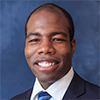The gonioscopy exam can have multiple challenges. Patients often worry about a lens touching their eye. Even in ideal circumstances, corneal striae, haze and ocular pathology can present additional difficulties.
Nevertheless, gonioscopy is key to preventing ocular complications of angle closure, identifying structures essential to the glaucoma exam and ultimately making a diagnosis. Here are seven tried-and-true tips for a great examination that I’ve picked up from my mentors over the years and continue to hone and teach to this day.
1. Keep Your Goal in Mind
The gonioscopy exam is designed to identify the proper angle structures in their natural position, including the iris insertion and any abnormal angle pathology. Thus, you want to obtain the best possible view so you can minimize distortion and maximize your ability to identify these structures. To do so, you need a comfortable patient, an efficient exam, ideal lighting and good technique.
2. Make the Patient Comfortable
To reduce the patient’s anxiety, explain the gonioscopy process in terms he or she will understand. For example, I often tell my patients, “I’m going to put a small contact lens on your eye to help see how the drainage angle is working. You will feel it lightly touch your upper eyelid, but it won’t hurt.”
3. Center the Lens
Place the lens on the center of the eye. A decentered lens can cause striae and distort the view. One easy way to identify a poorly centered lens is the appearance of air bubbles under a portion of the lens that’s not in contact with the cornea. Instead of pressing or pushing the lens towards the eye to correct, first try to recenter the lens. For narrow angles, have the patient look toward the mirror you are using so that you can have a better view.
4. Use a Short, Thin Beam
When using the slit lamp, keep in mind that a small beam causes less pupil constriction and prevents a change in the angle appearance. By angling the beam slightly to the left or right of perpendicular, you can also reduce the glare and improve the likelihood of seeing the parallelepiped (i.e., Schwalbe’s line, the point where the reflected light beams meet to indicate the edge of the clear cornea). Angling the beam in this manner will also help to identify the start of angle structures, even in one that’s lightly pigmented.
5. Look for the Landmarks
Apply gentle pressure with the gonio lens to open the angle and identify the iris insertion, peripheral anterior synechiae and further angle structures. If you can’t see angle structures from the side of Schwalbe’s line, try to count the angle structures starting from the iris insertion. The scleral spur is often one of the brightest white lines in the angle and serves as another important landmark.
6. Describe the Angle
If not used often, the Spaeth or Shaffer classification for describing angles may be difficult to remember. Therefore, the best way to describe the angle is to do just that: describe the angle. Important descriptors for dynamic gonioscopy include 1) a clear indication of how open the angle is in its native state (identifiable structures), 2) the amount of pigment, 3) the presence or absence of PAS, 4) iris insertion and angulation and 5) any additional visible structures.
7. Practice, Practice, Practice
I cannot stress this enough. Even though I am comfortable with gonioscopy, I continue to learn or see something new each day. It may be awkward and slow at first, but practicing gonioscopy will make you much more efficient and much more capable of performing a great exam.
* * *
 About the author: Anthony C. Gregory, MD, is a glaucoma specialist at California Eye Specialists in Pasadena, Calif. He studied medicine at Johns Hopkins and did his ophthalmology residency at Vanderbilt Eye Institute. He recently finished a glaucoma fellowship at the Emory Eye Center, where he worked under Anastasios P. Costarides, MD, PhD, and the rest of the glaucoma team.
About the author: Anthony C. Gregory, MD, is a glaucoma specialist at California Eye Specialists in Pasadena, Calif. He studied medicine at Johns Hopkins and did his ophthalmology residency at Vanderbilt Eye Institute. He recently finished a glaucoma fellowship at the Emory Eye Center, where he worked under Anastasios P. Costarides, MD, PhD, and the rest of the glaucoma team.